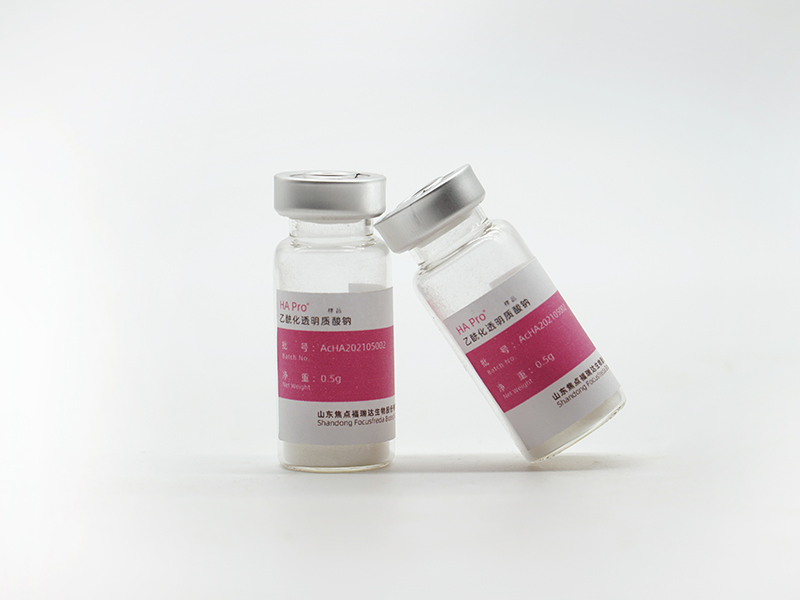
China wholesale Vegetable Glycerin And Hyaluronic Acid Manufacturers – HA PRO® ACETYLATED SODIUM HYALURONATE – Focusfreda
Short Description:
Product Introduction
Physical and chemical properties: Appearance is white or light yellow powder, easily soluble in water.
The product characteristics is as below
1. Super moisturizing
2. Scavenging free radicals, anti-oxidant and anti-aging
Anti-inflammatory repair

1. Super moisturizing
Saturated ammonium sulfate solution is used to maintain the relative humidity at 81%. Detect the weight difference between HA and AcHA powder placed for 1h-8h, the positive control glycerin, characterize its moisture retention; as shown in Figure 1, where AcHA is number 2: The test shows that within 1h, AcHA has much higher than glycerin and The moisture retention of ordinary HA; within 1-8h, the moisture retention of all samples decayed with time, but the moisture retention of AcHA was still higher than that of other controls.
HA1: low molecular weight sodium hyaluronate; HA2: acetylated sodium hyaluronate;
HA3: conventional molecular weight sodium hyaluronate;
Figure1: The average moisture retention rate of each sample at each time point
2. Scavenging free radicals, anti-oxidant and anti-aging
In ethanol solution, 1,1-diphenyl-2-trinitrophenylhydrazine (DPPH) molecules can form stable nitrogen-containing free radicals. It has a strong absorption at 517nm, and the free radical scavenger can pair with its one-electron to fade the solution. This principle is used to quantitatively determine the antioxidant capacity of biologically active substances. Through the impact test on the generation of DPPH free radicals, it is shown that compared with the control group, acetylated HA has the ability to scavenge DPPH free radicals, and exceeds the conventional molecular weight free radical scavenging level.
HA1: low molecular weight sodium hyaluronate;
AcHA: acetylated sodium hyaluronate
Figure 2: Free radical scavenging rate of sodium acetylated hyaluronate


3.Anti-inflammatory repair
The anti-inflammatory ability was determined by the enzyme-linked immunosorbent method. Studies have shown that 1µg/mL lipopolysaccharide (LPS) can stimulate HaCaT cells to produce pro-inflammatory factors, and the ability of the raw materials to inhibit the level of inflammatory factors was tested by ELISA. As shown in Figure 3, compared with ordinary hyaluronic acid, the expression of 1L-1α in the acetylated hyaluronic acid group was significantly reduced, and the test showed that AcHA has a significant ability to inhibit inflammatory factors.
HA2: acetylated sodium hyaluronate;
HA3: conventional molecular weight sodium hyaluronate:
Figure 3: Expression of 1L-1α in cells in different samples
Product specifications
| Product name | Acetylated sodium hyaluronate | |
| Product description | White or yellowish powder or granule | |
| Product Benefits | Super moisturizing, AcHA has much higher moisturizing properties than glycerin and ordinary HA;Scavenging free radicals, anti-oxidation and anti-aging, AcHA has the ability to scavenge DPPH free radicals, and exceeds the conventional molecular weight free radical scavenging level;
Inhibiting inflammation and repairing, AcHA has obvious ability to inhibit inflammatory factors compared with ordinary hyaluronic acid; |
|
| Product specification | Identification | A.Infrared absorption spectrophotometry |
| B.A color reaction occurs with uronic acids | ||
| C.It gives reaction(a)of sodium | ||
| Acetyl content |
23.0-29.0% |
|
| pH |
5.0-7.0 |
|
| Loss on drying |
≤10.0% |
|
| Residue on Ignition |
11.0%-16.0% |
|
| Intrinsic viscosity |
0.50-2.80dL/g |
|
| Heavy metal (as Pb) |
≤20ppm |
|
| Arsenic |
≤2.0ppm |
|
| Nitrogen content |
2.0-3.0% |
|
| Bacteria counts |
≤100CFU/g |
|
| Molds & Yeasts |
≤30CFU/g |
|
| Staphylococcus aureus |
Negative/g |
|
| Pseudomonas aeruginosa |
Negative/g |
|
| Storage Conditions | Store in airtight, shaded room temperature. | |
| Packing |
According to customer requirements |
|
| Shelf life | Two years (unopened packaging) | |
Instructions for use
Recommended dosage: 0.01%-0.1%;
Usage: easily soluble in water, can be directly added to the water phase; skin feels refreshing and not sticky
Application range: applied to cosmetics such as essence, facial mask, cream, lotion, etc.
Ingredients
Hyaluronic Acid & Tremella Fuciformis Polysaccharide
Collagen & Chondroitin Sulfate
Contact Us
 Address
Address
 Email
Email

© Copyright - 2010-2024 : All Rights Reserved. Hot Products - Sitemap
Sodium Hyaluronate Structure,
Food Grade Sodium Hyaluronate Powder,
Sodium Hyaluronate Powder,
Concentrated Sodium Hyaluronate,
Food Grade Sodium Hyaluronate,
Freda Sodium Hyaluronate Powder,





